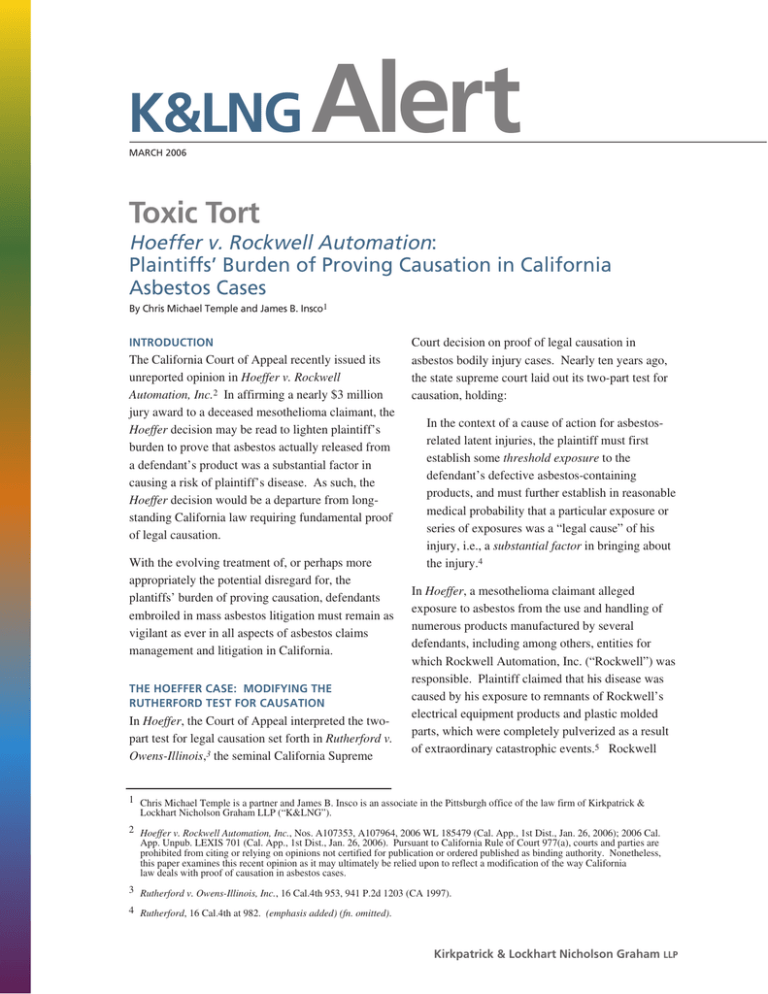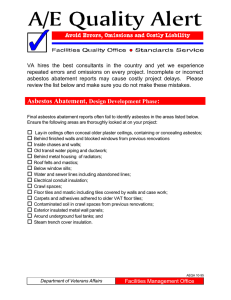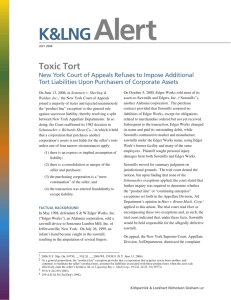
K&LNG
MARCH 2006
Alert
Toxic Tort
Hoeffer v. Rockwell Automation:
Plaintiffs’ Burden of Proving Causation in California
Asbestos Cases
By Chris Michael Temple and James B. Insco1
INTRODUCTION
The California Court of Appeal recently issued its
unreported opinion in Hoeffer v. Rockwell
Automation, Inc.2 In affirming a nearly $3 million
jury award to a deceased mesothelioma claimant, the
Hoeffer decision may be read to lighten plaintiff’s
burden to prove that asbestos actually released from
a defendant’s product was a substantial factor in
causing a risk of plaintiff’s disease. As such, the
Hoeffer decision would be a departure from longstanding California law requiring fundamental proof
of legal causation.
With the evolving treatment of, or perhaps more
appropriately the potential disregard for, the
plantiffs’ burden of proving causation, defendants
embroiled in mass asbestos litigation must remain as
vigilant as ever in all aspects of asbestos claims
management and litigation in California.
THE HOEFFER CASE: MODIFYING THE
RUTHERFORD TEST FOR CAUSATION
In Hoeffer, the Court of Appeal interpreted the twopart test for legal causation set forth in Rutherford v.
Owens-Illinois,3 the seminal California Supreme
Court decision on proof of legal causation in
asbestos bodily injury cases. Nearly ten years ago,
the state supreme court laid out its two-part test for
causation, holding:
In the context of a cause of action for asbestosrelated latent injuries, the plaintiff must first
establish some threshold exposure to the
defendant’s defective asbestos-containing
products, and must further establish in reasonable
medical probability that a particular exposure or
series of exposures was a “legal cause” of his
injury, i.e., a substantial factor in bringing about
the injury.4
In Hoeffer, a mesothelioma claimant alleged
exposure to asbestos from the use and handling of
numerous products manufactured by several
defendants, including among others, entities for
which Rockwell Automation, Inc. (“Rockwell”) was
responsible. Plaintiff claimed that his disease was
caused by his exposure to remnants of Rockwell’s
electrical equipment products and plastic molded
parts, which were completely pulverized as a result
of extraordinary catastrophic events.5 Rockwell
1 Chris Michael Temple is a partner and James B. Insco is an associate in the Pittsburgh office of the law firm of Kirkpatrick &
Lockhart Nicholson Graham LLP (“K&LNG”).
2 Hoeffer v. Rockwell Automation, Inc., Nos. A107353, A107964, 2006 WL 185479 (Cal. App., 1st Dist., Jan. 26, 2006); 2006 Cal.
App. Unpub. LEXIS 701 (Cal. App., 1st Dist., Jan. 26, 2006). Pursuant to California Rule of Court 977(a), courts and parties are
prohibited from citing or relying on opinions not certified for publication or ordered published as binding authority. Nonetheless,
this paper examines this recent opinion as it may ultimately be relied upon to reflect a modification of the way California
law deals with proof of causation in asbestos cases.
3 Rutherford v. Owens-Illinois, Inc., 16 Cal.4th 953, 941 P.2d 1203 (CA 1997).
4 Rutherford, 16 Cal.4th at 982. (emphasis added) (fn. omitted).
Kirkpatrick & Lockhart Nicholson Graham LLP
was the only defendant remaining at trial and the
jury awarded plaintiff approximately $3 million in
damages, including $2.4 million in non-economic
damages.
For purposes of the Hoeffer case, Rockwell
conceded that its products at issue would have
included plastic-like components engineered from
asbestos-reinforced phenolic molding compounds.6
Accordingly, Rockwell only challenged, and the
Hoeffer court only narrowly considered, the
sufficiency of the evidence under Rutherford, that is,
whether exposure to asbestos from defendant’s
product was, in reasonable medical probability, a
substantial factor in bringing about Mr. Hoeffer’s
risk of mesothelioma. Rockwell argued that the
plaintiff could not, as a matter of law, satisfy the
substantial factor requirement because the plaintiff
did not present any expert testimony quantifying or
characterizing the plaintiff’s exposure to asbestos
from its products at issue. As such, Rockwell
argued that plaintiff could not meet his burden by a
“reasonable medical probability” or otherwise.
The Rutherford court contemplated the “wide
variation in form and toxicity of asbestos products,”7
and further suggested that in evaluating the limits of
a substantial factor, courts should consider the
length, frequency, proximity and intensity of a
claimant’s exposure, the peculiar properties of the
individual product, and any alternative sources of a
claimant’s asbestos exposure.8 While the plaintiff
in Hoeffer did present evidence with respect to Mr.
Hoeffer’s exposure to defendant’s asbestoscontaining products, Rockwell argued that there was
no competent evidence of plaintiff’s actual exposure
to respirable asbestos generated from such products.
On the issue of exposure to dangerous asbestos
fibers – as opposed to mere product exposure –
plaintiff relied on two essential facts: first, that
some unidentified quantity or form of asbestos fiber
could, under the unusual circumstances of the case,
be liberated from the defendant’s products; and
second, that exposure to only one single asbestos
fiber from a defendant’s product is a sufficient legal
cause of his injury.9
Applying the Rutherford tests, the Hoeffer court
focused extensively on the length, frequency,
proximity and intensity of Hoeffer’s exposures to the
defendant’s products. As for alleged exposure to
harmful asbestos fibers from those products, the
court references only two bits of evidence: (1) that
plaintiff’s expert testified that “crushed or
pulverized electrical components would emit
asbestos fibers,” and (2) defendant’s expert “agreed
that pulverized electrical components would emit
fibers.”10 The court cited no evidence of the amount
of fibers, the size of the fibers, whether the fibers
5 The Hoeffer decision is based primarily on a highly unusual set of circumstances where a Navy ship’s gyroscope spinning at
tremendous speeds accidentally loosened from its mooring and caromed pinball-style from wall-to-wall in a small cabin and
pulverized everything in its path, including electrical equipment manufactured by defendants. It is rare, indeed, for electrical
equipment to be “pulverized” in such unusual circumstances.
6 Hoeffer, 2006 WL 185479 at *2, 2006 Cal. App. Unpub. LEXIS 701 at *7. It should be noted that only certain—not all—phenolic
molding compound formulas included asbestos fibers as a reinforcing material in electrical distribution products. It is unfair to
suggest that asbestos can generally be found in all electrical products or types of electrical equipment manufactured by a wide range
of companies in any given time frame. Moreover, asbestos fibers in the finished products molded from those limited formulas are
physically and chemically bound in the plastic-like molded product and generally do not release asbestos fibers of a harmful or
hazardous nature. See, e.g., Fionna Mowat, et al., Occupational Exposure to Airborne Asbestos from Phenolic Molding Material
(Bakelite) During Sanding, Drilling, and Related Activities, J. OCCUPATIONAL AND ENVTL. HYGIENE,
Oct. 2005 at 2:497-507.
7 Rutherford, 16 Cal.4th at 972.
8 Rutherford, 16 Cal.4th at 975.
9 Hoeffer, 2006 WL 185479 at *6, 2006 Cal. App. Unpub. LEXIS 701 at *19. Inexplicably, the Hoeffer court did not address or
decide whether plaintiff’s “single asbestos fiber theory” ran afoul of the Rutherford court’s admonition that a substantial factor
should not include exposures that are “infinitesimal” or “theoretical.” See Rutherford, 16 Cal.4th at 969 (citing People v. Caldwell,
36 Cal.3d 210, 220, 681 P.2d 274 (1984)).
10 Hoeffer, 2006 WL 185479 at *6, 2006 Cal. App. Unpub. LEXIS 701 at *18-19.
2
Kirkpatrick & Lockhart Nicholson Graham
LLP
|
MARCH 2006
were of a nature that they could possibly be inhaled
by plaintiff, or the potential hazards or risks posed
by the fibers. Certainly, nothing in the court’s
opinion refutes Rockwell’s core contention that
plaintiff utterly failed to quantify or to characterize
the nature of the alleged asbestos fiber from
defendant’s product.11
Notwithstanding the dearth of evidence
demonstrating any potential hazard or risk of injury
associated with actual “fibers” that “would have
been released” from defendant’s products under the
unusual circumstances of the Hoeffer case, the court
ultimately held “there was substantial evidence from
which the jury could conclude that exposure to
Rockwell’s asbestos-containing products was a
substantial factor in contribution to the aggregate
dose of asbestos….”12
LESSONS LEARNED: HOLD PLAINTIFFS TO THE
RUTHERFORD REQUIREMENTS
Perhaps unintentionally, the Hoeffer court
overlooked Rutherford’s focus on the frequency,
duration, intensity, or fiber type of the exposure to
harmful airborne asbestos and focused instead on
mere exposure to an asbestos-containing product.
If the Hoeffer court’s alteration of the Rutherford
result was intended, the second prong of the
Rutherford test was erroneously disregarded.
Defendants that manufactured, sold or supplied
products that contained any asbestos, regardless of
quantity or scientific improbability of fiber release,
should heed the potential consequences of the
court’s approach in Hoeffer. The plaintiffs’ bar is
increasingly targeting what have historically been
peripheral defendants whose products are
encapsulated and any asbestos constituent is
inextricably bound in a physical and chemical matrix
that suppresses the release of hazardous fibers in all
but the most extreme circumstances.
Opinions like Hoeffer may aid plaintiffs’ counsel in
their efforts to obtain verdicts against companies
merely because their products contained asbestos —
not because their products released respirable
asbestos fibers or because injured plaintiffs actually
breathed asbestos fibers released from those
products. Such a conclusion, however, would be
inconsistent with California law and the fundamental
causation requirements supporting product liability
claims in the United States.
Chris Michael Temple
ctemple@klng.com
412.355.6343
James B. Insco
jinsco@klng.com
412.355.6744
11 In contrast, in Jones v. John Crane, Inc., 132 Cal. App. 4th 990 (1995), the California Court of Appeal at least referenced plaintiff’s
presentation of evidence quantifying and characterizing the nature of the alleged asbestos fiber released from John Crane’s packing
and gasket materials.
12 Hoeffer, 2006 WL 185479 at *6, 2006 Cal. App. Unpub. LEXIS 701 at *17 (citing Rutherford, 16 Cal.4th at 976-977).
3
Kirkpatrick & Lockhart Nicholson Graham
LLP
|
MARCH 2006
K&LNG assists clients with toxic tort claims in multiple ways, including: serving as lead or special trial counsel in individual cases
tried to juries and as National Coordinating Counsel and/or National Trial Counsel in mass tort cases involving multiple, repetitive
claims for exposures to substances such as asbestos or silica. As such, the firm is intimately involved nationally in all facets of trial and
pretrial preparation, the development of strategic approaches to complex problems, and the management of information in cases.
If you would like more information on our toxic tort litigation and trial capabilities, please contact one of the lawyers listed below:
NATIONAL COORDINATING / NATIONAL TRIAL COUNSEL
Terry Budd
James A. Lowery, III
Mary O’Day
Michael J. Ramirez
Chris M. Temple
412.355.8672
214.939.4983
412.355.6700
214.939.4946
412.355.6343
CALIFORNIA
Raymond L. Gill
PENNSYLVANIA/OHIO
415.249.1088
rgill@klng.com
305.539.3324
dcasey@klng.com
James A. Pranske
Warren R. Westberg
617.261.3179
jking@klng.com
UNITED KINGDOM
FLORIDA
Daniel A. Casey
tbudd@klng.com
jlowery@klng.com
moday@klng.com
mramirez@klng.com
ctemple@klng.com
Nicholas P. Vari
412.355.8365 nvari@klng.com
TEXAS
214.939.4985
214.939.4984
jpranske@klng.com
wwestberg@klng.com
MASSACHUSETTS
Jeffrey S. King
Jane Harte-Lovelace +44.20.7360.8172 jharte-lovelace@klng.com
NEW YORK/NEW JERSEY
Michael E. Waller
973.848.4132
mwaller@klng.com
WASHINGTON, D.C./ VIRGINIA
David T. Case
202.778.9084 dcase@klng.com
www.klng.com
BOSTON • DALLAS • HARRISBURG • LONDON • LOS ANGELES • MIAMI • NEWARK • NEW YORK • PALO ALTO • PITTSBURGH • SAN FRANCISCO • WASHINGTON
Kirkpatrick & Lockhart Nicholson Graham (K&LNG) has approximately 1,000 lawyers and represents entrepreneurs, growth and middle market companies,
capital markets participants, and leading FORTUNE 100 and FTSE 100 global corporations nationally and internationally.
K&LNG is a combination of two limited liability partnerships, each named Kirkpatrick & Lockhart Nicholson Graham LLP, one qualified in Delaware, U.S.A. and
practicing from offices in Boston, Dallas, Harrisburg, Los Angeles, Miami, Newark, New York, Palo Alto, Pittsburgh, San Francisco and Washington and one
incorporated in England practicing from the London office.
This publication/newsletter is for informational purposes and does not contain or convey legal advice. The information herein should not be used or relied
upon in regard to any particular facts or circumstances without first consulting a lawyer.
Data Protection Act 1988—We may contact you from time to time with information on Kirkpatrick & Lockhart Nicholson Graham LLP seminars and with our
regular newsletters, which may be of interest to you. We will not provide your details to any third parties. Please e-mail cgregory@klng.com if you would
prefer not to receive this information.
© 2006 KIRKPATRICK & LOCKHART NICHOLSON GRAHAM LLP. ALL RIGHTS RESERVED.
Kirkpatrick & Lockhart Nicholson Graham
LLP
|
MARCH 2006






